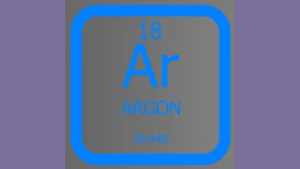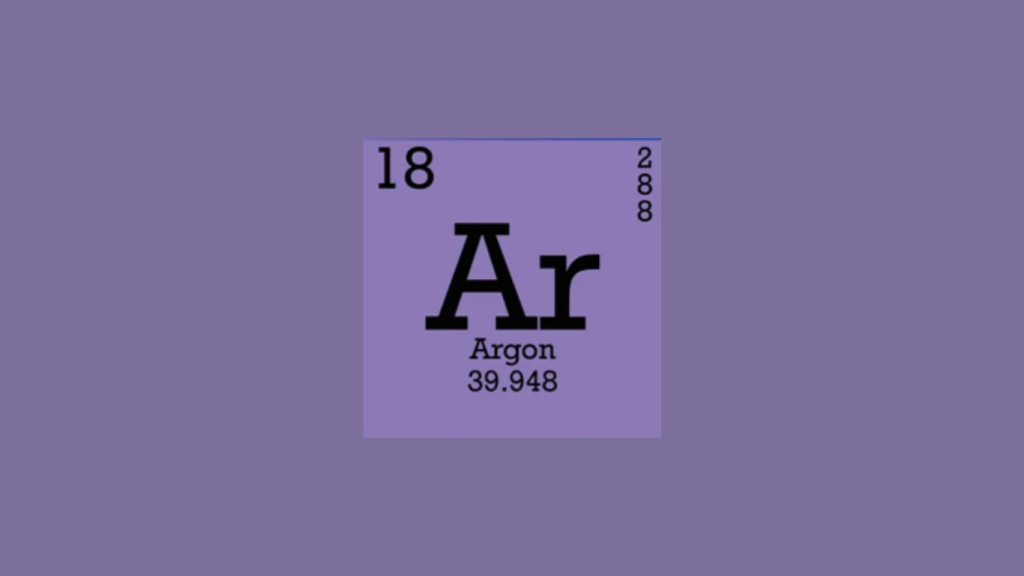Argon has eight valence electrons. It resides in Group 18 of the periodic table.
Argon is a noble gas with the chemical symbol Ar and atomic number 18. It is known for its inert nature, being colourless, odourless, and tasteless. Argon is about 0. 93% of the Earth’s atmosphere, making it the third most abundant gas.
Argon’s primary use is in industries where it provides an inert atmosphere, such as welding and semiconductor manufacturing. It is also used in incandescent and fluorescent lighting. Its complete outer electron shell renders it highly stable and non-reactive. Understanding argon’s properties and uses is essential for various scientific and industrial applications.
Introduction To Argon
Argon is a noble gas that plays a crucial role in chemistry. It is colourless, odourless, and tasteless. Argon occupies the 18th group in the periodic table, sharing space with other noble gases.
This element is abundant in the Earth’s atmosphere, making up about 0.93% of the air we breathe.
Elemental Background
The symbol Ar represents Argon, which has an atomic number of 18. This means argon has 18 protons in its nucleus. The atomic mass of argon is approximately 39.95 atomic mass units (AMU).
| Property | Value |
|---|---|
| Symbol | Ar |
| Atomic Number | 18 |
| Atomic Mass | 39.95 amu |
Importance In Chemistry
Argon is known for its inertness, meaning it does not easily react with other elements. This makes it valuable in various applications.
- Welding: Argon is used to create an inert atmosphere.
- Lighting: It is used in neon lights and bulbs.
- Scientific Research: Argon serves as a protective shield in experiments.
Argon’s inert nature is due to its full outer shell of electrons. This stability makes argon unique among elements.
Electron Configuration Basics
Understanding the electron configuration of elements is essential in chemistry. It helps in predicting chemical properties and behaviours. Argon, a noble gas, has a unique electron arrangement. Let’s dive into the basics of electron configuration.
Understanding Electrons
Electrons are tiny particles within an atom. They have a negative charge. Electrons orbit the nucleus of an atom. Each electron carries a specific amount of energy.
Atoms have different numbers of electrons. This number defines their chemical properties. Argon has 18 electrons.
Shells And Subshells
Electrons are arranged in shells and subshells. Shells are energy levels around the nucleus. Each shell can hold a specific number of electrons.
- The first shell holds up to 2 electrons.
- The second shell holds up to 8 electrons.
- The third shell also holds up to 8 electrons.
Within shells, there are subshells. Subshells are denoted by the letters s, p, d, and f.
| Subshell | Maximum Electrons |
|---|---|
| s | 2 |
| p | 6 |
| d | 10 |
| f | 14 |
Argon’s electron configuration is 2, 8, 8. This means it has:
- 2 electrons in the first shell
- 8 electrons in the second shell
- 8 electrons in the third shell
This arrangement makes argon stable and unreactive.
Argon’s Electron Configuration
Argon is a noble gas with unique electron configuration characteristics. Understanding its electron configuration provides insight into its chemical properties and behaviour.
Atomic Number And Structure
Argon has an atomic number of 18. This means it has 18 protons in its nucleus. The atomic number also equals the number of electrons in a neutral atom.
The structure of an argon atom includes a nucleus surrounded by electrons in various shells. Electrons occupy specific energy levels or shells around the nucleus.
Filling The Shells
The electron configuration of argon follows the order of filling the electron shells. The first shell can hold up to 2 electrons. The second shell can hold up to 8 electrons. The third shell can also hold up to 8 electrons.
Argon’s electron configuration is written as: 1s2 2s2 2p6 3s2 3p6.
This configuration shows that argon has a full outer shell. Its valence shell contains 8 electrons, making it stable and unreactive.
Here’s a quick breakdown in a table format:
| Shell | Electrons |
|---|---|
| 1st Shell | 2 |
| 2nd Shell | 8 |
| 3rd Shell | 8 |
Argon’s filled shells make it part of the noble gases group, which is known for its stability and inertness. Therefore, argon does not easily form compounds with other elements.
Valence Electrons Explained
Valence electrons are the outermost electrons of an atom. They play a crucial role in chemical bonding and reactions. Understanding valence electrons can help you predict an element’s behavior.
Definition And Significance
Valence electrons are the electrons in the outermost shell of an atom. These electrons determine how an element reacts with others. Elements with the same number of valence electrons often exhibit similar properties.
For instance, argon has eight valence electrons. This makes it very stable. The stability arises because its outer shell is full. Therefore, argon rarely participates in chemical reactions.
Role In Chemical Reactions
Valence electrons are key to understanding chemical reactions. Atoms seek to fill or empty their outer shell to become stable. This drive leads to the formation of bonds.
Argon’s eight valence electrons make it an inert gas. It does not easily form bonds because its outer shell is already full. This makes argon very stable and non-reactive.
Here’s a quick summary in a table:
| Element | Valence Electrons | Reactivity |
|---|---|---|
| Argon | 8 | Very Low |
Understanding valence electrons helps in predicting chemical behavior. This is crucial in fields like chemistry and material science.
Determining Argon’s Valence Electrons
Understanding the number of valence electrons is crucial in chemistry. It helps predict an element’s reactivity and bonding behavior. Here, we will explore how to determine the number of valence electrons in argon.
Electronic Structure
Argon is a noble gas with the atomic number 18. This means it has 18 protons and 18 electrons. The electrons are arranged in different energy levels or shells around the nucleus.
The electronic configuration of argon is written as: 1s2 2s2 2p6 3s2 3p6. This configuration shows the distribution of electrons in each shell.
Outer Shell Analysis
To determine the valence electrons, focus on the outermost shell. For argon, this is the third shell. The third shell contains the 3s and 3p orbitals.
In argon, the third shell is completely filled with electrons. It has 2 electrons in the 3s orbital and 6 electrons in the 3p orbital. This gives a total of 8 electrons in the outermost shell.
| Shell | Number of Electrons |
|---|---|
| 1st Shell (1s) | 2 |
| 2nd Shell (2s, 2p) | 8 |
| 3rd Shell (3s, 3p) | 8 |
Since the outermost shell is completely filled, argon has a stable electronic configuration. Therefore, argon has 8 valence electrons.
This stable configuration makes argon chemically inert. It rarely forms compounds with other elements.

Argon In The Periodic Table
Argon is a fascinating element in the periodic table. It holds the atomic number 18. Argon is a noble gas, found in Group 18. This element has unique properties that make it special.
Group 18 Elements
Group 18 elements are also known as noble gases. They include:
- Helium (He)
- Neon (Ne)
- Argon (Ar)
- Krypton (Kr)
- Xenon (Xe)
- Radon (Rn)
These elements share common characteristics. They are all colorless, odorless, and tasteless gases. Noble gases are very stable because of their full valence electron shells.
Noble Gas Characteristics
Noble gases have unique characteristics that set them apart. Here are some key points:
- Non-reactive: Noble gases do not easily form compounds.
- Full valence shells: These elements have complete outer electron shells.
- Low boiling points: They remain gases at room temperature.
Argon, like other noble gases, has a full valence shell. This makes it very stable. Argon is often used in light bulbs and welding. The full valence shell means Argon has 8 valence electrons.
| Element | Valence Electrons |
|---|---|
| Helium | 2 |
| Neon | 8 |
| Argon | 8 |
| Krypton | 8 |
| Xenon | 8 |
| Radon | 8 |
Understanding the properties of Argon helps in many applications. It’s a key element in scientific studies and industrial uses.
Comparing Valence Electrons
Understanding valence electrons is essential in studying chemical properties. Valence electrons are the outermost electrons of an atom. They determine how an element will react chemically. Argon, a noble gas, has a specific number of valence electrons that contribute to its unique properties.
Argon Vs. Other Noble Gases
Noble gases are unique in the periodic table. They are known for their chemical inertness. Below is a comparison of valence electrons in some noble gases:
| Noble Gas | Valence Electrons |
|---|---|
| Helium (He) | 2 |
| Neon (Ne) | 8 |
| Argon (Ar) | 8 |
| Krypton (Kr) | 8 |
| Xenon (Xe) | 8 |
| Radon (Rn) | 8 |
Argon, like other noble gases except helium, has eight valence electrons. This characteristic plays a significant role in its chemical behavior.
Chemical Stability
Noble gases, including argon, are known for their chemical stability. This stability is due to their full valence electron shells. A full outer shell makes these gases highly unreactive.
Here are some key points:
- Argon has a full outer shell with eight electrons.
- This full shell makes argon chemically inert.
- Argon rarely forms compounds with other elements.
The chemical stability of noble gases makes them valuable in various applications. For example, argon is used in light bulbs to prevent the filament from oxidizing.
Applications Of Argon
Argon is a noble gas with many uses. It is inert and doesn’t react easily with other elements, making it ideal for various applications. Let’s explore its industrial uses and role in scientific research.
Industrial Uses
Argon is widely used in welding. It creates a shield around the weld area. This prevents oxidation and contamination. It’s especially useful in welding metals like aluminum and stainless steel.
Another important use is in the production of incandescent and fluorescent light bulbs. Argon gas prevents the filament from burning out quickly. This extends the life of the bulbs.
Argon is also employed in the manufacturing of high-quality steel. It helps to remove impurities during the steel-making process. This results in stronger and more durable steel products.
Scientific Research
Argon plays a crucial role in scientific research. It is used in gas chromatography. This technique separates and analyzes compounds that can be vaporized.
Argon is also utilized in the field of cryogenics. Liquid argon is used to study substances at very low temperatures. This helps scientists understand the properties of materials in extreme conditions.
In the field of physics, argon is used in Geiger counters. These devices detect and measure ionizing radiation. Argon gas enhances the sensitivity of these detectors. Google maps
Frequently Asked Questions
How Many Valence Electrons In Argon Atom?
Argon has eight valence electrons. It belongs to the noble gases group. This makes argon stable and non-reactive.
Why Does Argon Have 8 Valence Electrons?
Argon has eight valence electrons because it is in Group 18. This makes it chemically stable and inert.
Is Argon Reactive With Other Elements?
Argon is not reactive with other elements. Its full valence shell makes it stable and inert.
What Is The Electron Configuration Of Argon?
Argon’s electron configuration is 1s² 2s² 2p⁶ 3s² 3p⁶. This shows a complete outer shell.
Conclusion
Argon, with its complete octet, has eight valence electrons. This makes it stable and non-reactive. Understanding argon’s electron configuration helps in grasping the periodic table better. Keep exploring more elements to deepen your chemistry knowledge. Stay curious and continue learning about the fascinating world of atoms and molecules.
